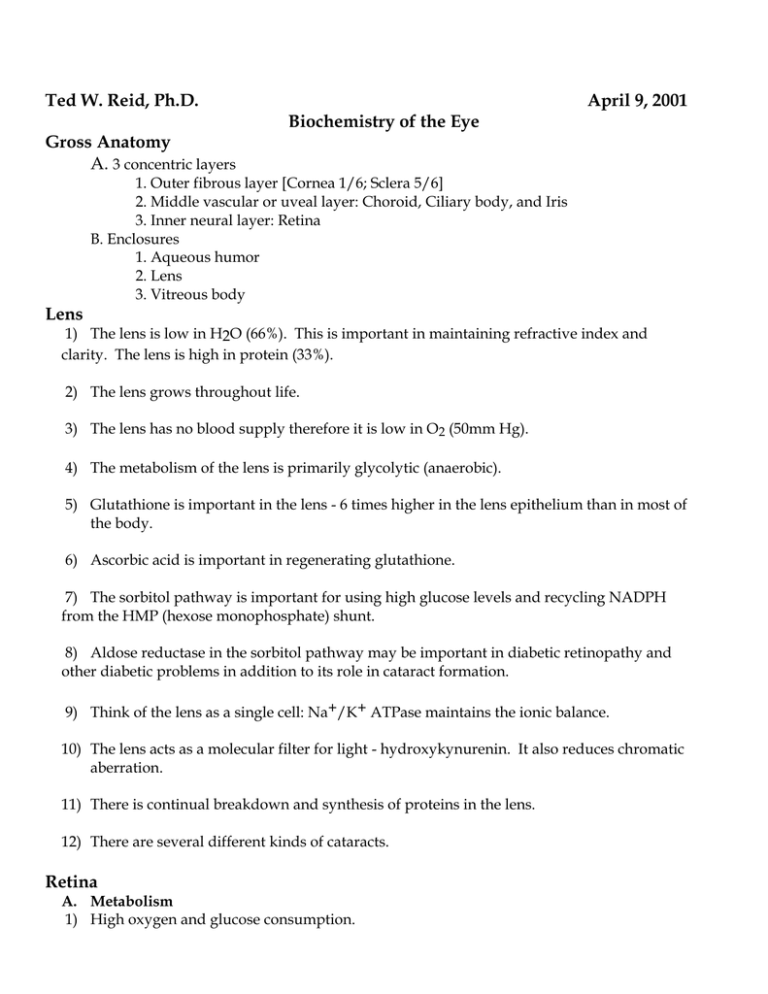Ted W. Reid, Ph.D. April 9, 2001 Biochemistry of the Eye
advertisement

Ted W. Reid, Ph.D. Gross Anatomy A. 3 concentric layers Lens Biochemistry of the Eye April 9, 2001 1. Outer fibrous layer [Cornea 1/6; Sclera 5/6] 2. Middle vascular or uveal layer: Choroid, Ciliary body, and Iris 3. Inner neural layer: Retina B. Enclosures 1. Aqueous humor 2. Lens 3. Vitreous body 1) The lens is low in H2O (66%). This is important in maintaining refractive index and clarity. The lens is high in protein (33%). 2) The lens grows throughout life. 3) The lens has no blood supply therefore it is low in O2 (50mm Hg). 4) The metabolism of the lens is primarily glycolytic (anaerobic). 5) Glutathione is important in the lens - 6 times higher in the lens epithelium than in most of the body. 6) Ascorbic acid is important in regenerating glutathione. 7) The sorbitol pathway is important for using high glucose levels and recycling NADPH from the HMP (hexose monophosphate) shunt. 8) Aldose reductase in the sorbitol pathway may be important in diabetic retinopathy and other diabetic problems in addition to its role in cataract formation. 9) Think of the lens as a single cell: Na+/K+ ATPase maintains the ionic balance. 10) The lens acts as a molecular filter for light - hydroxykynurenin. It also reduces chromatic aberration. 11) There is continual breakdown and synthesis of proteins in the lens. 12) There are several different kinds of cataracts. Retina A. Metabolism 1) High oxygen and glucose consumption. 2) High requirement for protein and phospholipid synthesis. 3) The retina is constantly renewed in a stepwise manner. 4) Light converts 11-cis retinal to the all trans form. B. Phototransduction (how a photon of light sends a signal to the brain) 1) Light converts rhodopsin to a form that activates transducin (GDP-->GTP). 2) Transducin activates phosphodieterase (PDE) 3) Phosphodiesterase decreases cGMP. 4) cGMP increases Na+ inflow in the photoreceptor cell. Thus, light is an off signal. 5) Ratio of proteins (or second messengers) in the eye: 900 rhodopsin / 1 PDE / 2 cGMP. 6) However, 1 rhodopsin activates 2000 PDE which hydrolyzes 2,500,000 cGMP/sec. Light Damage 1) Small amounts of light are harmful. 2) The lens protects against 315-400 nm light. 3) Carotinoids protect against 400-500 nm light in the macula. 4) Pigment in the iris helps to protect against light damage. 5) Pigment in the RPE (retinal pigment epithelium) doesn't protect much (probably used to block light scatter). 6) The cornea absorbs almost all of the damaging UV. Oxygen 1) Lipid oxidation (polyunsaturated fatty acids) - PUFA 2) The following play a role in oxidation protection in the retina: a. Superoxide dismutase b. Glutathione c. Ascorbate (vitamin C) d. Vitamin E e. Selenium f. Taurine g. Chromium (?)





